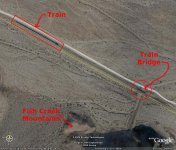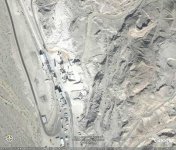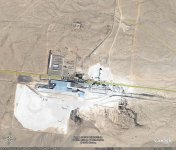Oroblanco
Gold Member
- Jan 21, 2005
- 7,841
- 9,867
- Detector(s) used
- Tesoro Lobo Supertraq, (95%) Garrett Scorpion (5%)
Greetings everyone,
In response to the request for more legends that might be suitable for a new forum, here is one of the most famous lost mine legends in the southwest - the famous Pegleg Smith's lost mine of black gold nuggets.
The story goes that Thomas L. Smith, better known as Pegleg Smith, (born 1801 died 1866) a real person who was a mountain man, prospector, horse thief and fur trapper in the misty period of before the California gold rush of '49, accidentally found a deposit of gold and was never able to relocate the site.
Pegleg Smith told people that he lost his leg in a fight with Indians in New Mexico, however Cyrus Alexander stated that Smith was accidentally shot in the knee by a drunken reveler at a mountain fur rendesvous, which resulted in his getting a wooden peg leg. The loss of such a vital limb did not even slow Smith down. Some time in the late 1820's or early 1830's (most sources date the journey to 1829) he took his train of mules loaded with furs to csell in the Spanish settlements of California. While crossing the Mojave desert in southern California, somewhere near what is today the Salton Sea (which was dry at the time) he lost his bearings. Spotting three flat-topped hills nearby, he decided to climb up the nearest one and try to get his bearings again. When he reached the top of the relatively small, flat topped hill, he noticed the ground littered with black pebbles. Almost absent mindedly, he picked up a few and they were surprisingly heavy. Thinking they may be copper, he put them in his pocket and started gazing around for a recognizable landmark. He did spy a landmark he recognized and headed back down to continue on his journey.
The story goes that Pegleg made it to Los Angeles and sold his furs for a great profit, so in the mountain man way went on a drinking binge. While in town he did learn that the black pebbles were really a desert varnish coating solid gold nuggets! He made such a ruckus that he was booted out of town. Pegleg spent many years searching for those three flat topped hills but never managed to relocate the site. Smith sold maps to the lost mine as well as claims to other prospectors for years before his death in a San Francisco hospital in 1866.
In the 1920's railroad man and treasure hunter John Mitchell happened to be in the same region when a meteorite was spotted. He got a mule and directions from the local witnesses to go and find the meteorite. While out in the desert, he got lost. In the same way as Pegleg had done, Mitchell climbed a flat topped hill and found that he could see a railroad junction in the distance, and that the ground on top of the hill was littered with black pebbles. He picked up a few and thought they were remarkably heavy for their size so filled a sack for future possibilities, kept a few in a pocket and headed for the railroad junction. He did find the meteorite and went on his way. More than twenty years later, he happened to hear of the tale of Pegleg's black gold nuggets and decided to hit one of the pebbles he had kept (he had stashed the bag full in the hills, not wishing to haul it out along with the meteorite) with a hammer, and sure enough the black crust came off revealing a gold nugget!. Mitchell was too old at the time but passed on his story, and added that the hill he had climbed was also covered with brown hematites (a natural iron, often causes a false hit with metal detectors and known as a "hot rock") and that the three hills were not to be seen.
In the 1960's a man contacted Desert USA magazine and claimed to have found the famous Pegleg mine. He said that the mine was within twenty miles of the Salton Sea, and that the flat topped hill was one of two, not three. He even sent in several black gold nuggets to the editors of the magazine to prove he was not telling a tale. According to him, he recovered ALL of the gold nuggets and made a fair but not huge fortune, traveling to Nome Alaska to sell the gold without revealing the secret of where he had found it.
There are related stories as well, which I will add later - incidents where different individuals found black-crusted gold nuggets in the area but were unable to return to the site. A similar lost mine exists in Arizona, somewhere north of Yuma and an old corral; a cowhand throwing pebbles to herd cattle found some of the black pebbles to be very heavy and these later proved to be gold. Desert varnish is a very real phenomenon and it will form a crust over even gold. The black gold nuggets sent in to the editors of Desert USA magazine were real - though there is even a "Pegleg Liars Contest" the fact is the story is based on a real gold location; perhaps someone will find it again!
I have personally hunted for this lost mine, and believe it does exist. I found brown hematites in the Chuckwallas and the Orocopia mountains, along with at least a dozen flat topped hills, but none of them had any black pebbles. Many Pegleg hunters have sought the flat topped hills in the Anza-Borrego park, as the editors of Desert USA magazine were convinced that was the true location, but no one has yet found the gold there either.
I hope I will not get in trouble for borrowing this image, here is a map showing the area where the famous gold is:

More articles online at:
http://www.desertusa.com/magnov97/gold/nov_gold2.html
The man who found Pegleg's gold:
http://www.desertusa.com/magdec97/gold/pegleg.html
http://www.desertusa.com/magdec97/gold/pegleg2.html
Pegleg Smith's monument:
http://www.roadsideamerica.com/attract/CABORpegleg.html
Great details on the life of Thomas L. Smith
http://experts.about.com/e/t/th/Thomas_L._Smith.htm
I will add more links in future.
Where is Pegleg's lost mine?
Oroblanco
In response to the request for more legends that might be suitable for a new forum, here is one of the most famous lost mine legends in the southwest - the famous Pegleg Smith's lost mine of black gold nuggets.
The story goes that Thomas L. Smith, better known as Pegleg Smith, (born 1801 died 1866) a real person who was a mountain man, prospector, horse thief and fur trapper in the misty period of before the California gold rush of '49, accidentally found a deposit of gold and was never able to relocate the site.
Pegleg Smith told people that he lost his leg in a fight with Indians in New Mexico, however Cyrus Alexander stated that Smith was accidentally shot in the knee by a drunken reveler at a mountain fur rendesvous, which resulted in his getting a wooden peg leg. The loss of such a vital limb did not even slow Smith down. Some time in the late 1820's or early 1830's (most sources date the journey to 1829) he took his train of mules loaded with furs to csell in the Spanish settlements of California. While crossing the Mojave desert in southern California, somewhere near what is today the Salton Sea (which was dry at the time) he lost his bearings. Spotting three flat-topped hills nearby, he decided to climb up the nearest one and try to get his bearings again. When he reached the top of the relatively small, flat topped hill, he noticed the ground littered with black pebbles. Almost absent mindedly, he picked up a few and they were surprisingly heavy. Thinking they may be copper, he put them in his pocket and started gazing around for a recognizable landmark. He did spy a landmark he recognized and headed back down to continue on his journey.
The story goes that Pegleg made it to Los Angeles and sold his furs for a great profit, so in the mountain man way went on a drinking binge. While in town he did learn that the black pebbles were really a desert varnish coating solid gold nuggets! He made such a ruckus that he was booted out of town. Pegleg spent many years searching for those three flat topped hills but never managed to relocate the site. Smith sold maps to the lost mine as well as claims to other prospectors for years before his death in a San Francisco hospital in 1866.
In the 1920's railroad man and treasure hunter John Mitchell happened to be in the same region when a meteorite was spotted. He got a mule and directions from the local witnesses to go and find the meteorite. While out in the desert, he got lost. In the same way as Pegleg had done, Mitchell climbed a flat topped hill and found that he could see a railroad junction in the distance, and that the ground on top of the hill was littered with black pebbles. He picked up a few and thought they were remarkably heavy for their size so filled a sack for future possibilities, kept a few in a pocket and headed for the railroad junction. He did find the meteorite and went on his way. More than twenty years later, he happened to hear of the tale of Pegleg's black gold nuggets and decided to hit one of the pebbles he had kept (he had stashed the bag full in the hills, not wishing to haul it out along with the meteorite) with a hammer, and sure enough the black crust came off revealing a gold nugget!. Mitchell was too old at the time but passed on his story, and added that the hill he had climbed was also covered with brown hematites (a natural iron, often causes a false hit with metal detectors and known as a "hot rock") and that the three hills were not to be seen.
In the 1960's a man contacted Desert USA magazine and claimed to have found the famous Pegleg mine. He said that the mine was within twenty miles of the Salton Sea, and that the flat topped hill was one of two, not three. He even sent in several black gold nuggets to the editors of the magazine to prove he was not telling a tale. According to him, he recovered ALL of the gold nuggets and made a fair but not huge fortune, traveling to Nome Alaska to sell the gold without revealing the secret of where he had found it.
There are related stories as well, which I will add later - incidents where different individuals found black-crusted gold nuggets in the area but were unable to return to the site. A similar lost mine exists in Arizona, somewhere north of Yuma and an old corral; a cowhand throwing pebbles to herd cattle found some of the black pebbles to be very heavy and these later proved to be gold. Desert varnish is a very real phenomenon and it will form a crust over even gold. The black gold nuggets sent in to the editors of Desert USA magazine were real - though there is even a "Pegleg Liars Contest" the fact is the story is based on a real gold location; perhaps someone will find it again!
I have personally hunted for this lost mine, and believe it does exist. I found brown hematites in the Chuckwallas and the Orocopia mountains, along with at least a dozen flat topped hills, but none of them had any black pebbles. Many Pegleg hunters have sought the flat topped hills in the Anza-Borrego park, as the editors of Desert USA magazine were convinced that was the true location, but no one has yet found the gold there either.
I hope I will not get in trouble for borrowing this image, here is a map showing the area where the famous gold is:

More articles online at:
http://www.desertusa.com/magnov97/gold/nov_gold2.html
The man who found Pegleg's gold:
http://www.desertusa.com/magdec97/gold/pegleg.html
http://www.desertusa.com/magdec97/gold/pegleg2.html
Pegleg Smith's monument:
http://www.roadsideamerica.com/attract/CABORpegleg.html
Great details on the life of Thomas L. Smith
http://experts.about.com/e/t/th/Thomas_L._Smith.htm
I will add more links in future.
Where is Pegleg's lost mine?
Oroblanco
Amazon Forum Fav 👍
Last edited by a moderator:


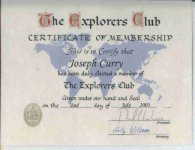
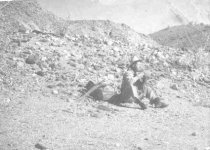
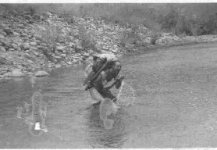
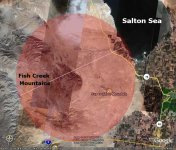

 (heh heh!) Thar's gold in them thar hills, pal-o-mine!
(heh heh!) Thar's gold in them thar hills, pal-o-mine! 

